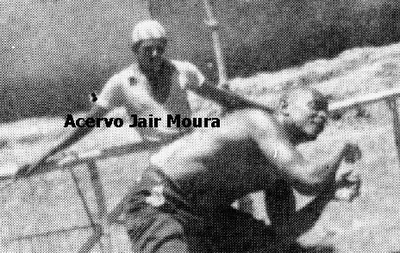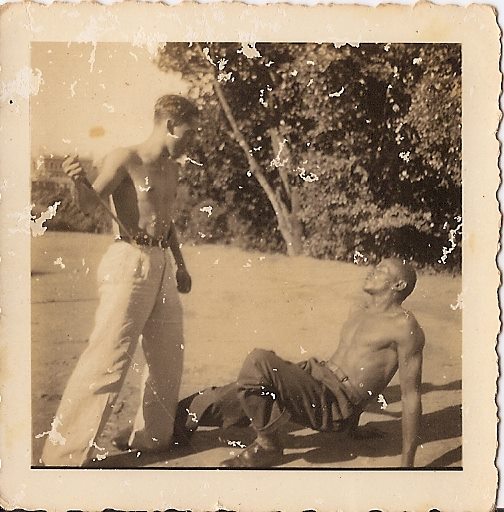
https://www.youtube.com/watch?v=vfM0FBCqpQM
When I trained Regional (the original style of Mestre Bimba, taught by Filhos de Bimba today), a question often came to my mind: How did Mestre Bimba ginga?
I had enormous respect for Mestre Bimba and he was my idol at the time; so I really wanted to know how would the king of capoeira do the basic movement of (Bahian) capoeira.
I only had the photo below; and a short note of somebody who remembered that Bimba's ginga that it was 'an odd twisting ginga'. Of course, back then, I could learn nothing from that.

However, now, with my understanding of capoeiragem and of body mechanics, I believe I can answer that old question of mine. What is better, I can show you the way Bimba used to ginga!
First of all, he certainly used Monkey+Seduction1 mechanics for his ginga - the common Bahian ginga. Back in Bimba's time, there was no other ginga (also, Bimba would not be able to throw LightLegs kicks unless he used this ginga); the other gingas(Tiger, Crane etc) are modern degenerations, brought into capoeira in the 80s and 90s.
However, the Monkey+Seduction1 ginga is neither odd nor twisty. So let us look at the photo again.
Bimba indeed uses the common Bahian ginga mechanics here. This I can see in the photo. However, there is more! Aside from Monkey+Seduction1, Bimba uses Nemer archetype on top of it!
-
Nemer is a special archetype that can be used to 'put on a false facade'; to hide the real mechanics. It can be used in fighting to hide your intentions from the enemy before it is too late; so the techniques are executed from 'cold start' (without telegraphing). It is a very powerful concept; I know it from kungfu, but I never have seen it used in Capoeira.
However, Bimba clearly uses it in his ginga! And what is more: Adding the Nemer archetype to the Bahian ginga (guarda alta only; it does not work for other two guardas) - makes it indeed a bit odd and twisty!
And best of all, it looks like the position on the photo.
-
So this was the secret of Bimba's ginga: He used the common Bahian guarda alta Monkey+Seduction1 ginga;but with Nemer archetype to mask his intentions. This made his ginga odd and twisty; and also masked the intentions of his attacks. Coupled with quickstarted LightLegs kicks and his size, no wonder he could crush his opponents in three blows. (Because Nemer masked the kick and LightLegs gave it a quickstart, thus making it practicall indefensible).
This gives us another 'trick' of Bahian capoeira: Nemer ginga.
-
Excursus:
It is also easy to see now why Bimba favoured Cocorinha as an evade (even though I believe this was not a very good choice): Because the above described ginga automatically leads you to the squat in the front.
It also leads you to the 'Voadora' LightLegs evade (see the article on Carioca evades); which, I believe, Bimba used too to evade straight kicks.
It even naturally leads into frontal Negativa, another favourite of Bimba.
(In the back, it leads to a LightLegs Queda de tres fall; something you do not see in Regional but which Bimba clearly used - see the photo on the right)
From this also follows why Bimba's students in fact did not use his evasion system (Cocorinha nor Voadora; instead using different way of leaning the torso, which later lead to the esquivas of modern capoeira): Because they did not have his Nemer ginga.
-
From Cocorinha, if entered from the Nemer ginga - ie a Nemer Cocorinha! - , it is also easy and natural to throw a low Bahian rasteira; a Bahian lifting cabecada; or even a MLDC. These are the counterattacks that formed the core of Bimba's system. We will look at it in another article.
-
The above is a very important fact; because it shows that Bimba's system of evasions (Nemer Cocorinha, Negativa, Queda de tres, Voadora) and counterattacks was intimately tied with his special ginga (Nemer ginga).
His students, who used the normal Bahian ginga (Monkey+Seduction1), thus had not found these evasions natural, and started introducing their own (various types of 'esquivas'); which in the end completely replaced Bimba's evasions. (In Mestre Decanio's book, we can find out that Bimba did not like it, calling it 'lazy esquivas').
Thus Bimba's Regional system was build around his Nemer ginga; without this special ginga, it will just never 'click together'. Without his Nemer ginga, Bimba's system gradually died out.
-
Also, from Nemer ginga, it is very easy to throw almost undetectable hand attacks(Galopante, Asfixiante, Godeme); also favoured by Bimba. But that is a topic for another article!
-
Conclusion:
Thus Bimba's Nemer ginga is not just some historical curiosity; it is a real gem for every lover of classic capoeiragem, because it explains why Bimba's original Regional looked the way it did (Cocorinhas, Negativas, counters, kicks, hand attacks etc) and also why it was so combat effective!
Word of warning
Beware, however: Nemer is a useful combat mechanics, but at the same time, it is a dangerous archetype for the user. It is one you can easily get addicted to and then it will cause you a real spiritual damage.
Therefore, if you want to train Bimba's Nemer capoeira, always take care to get rid of Nemer archetype after you stop practicing. Do not use Nemer outside of training/fighting!
This Web Page was Built with PageBreeze Free HTML Editor